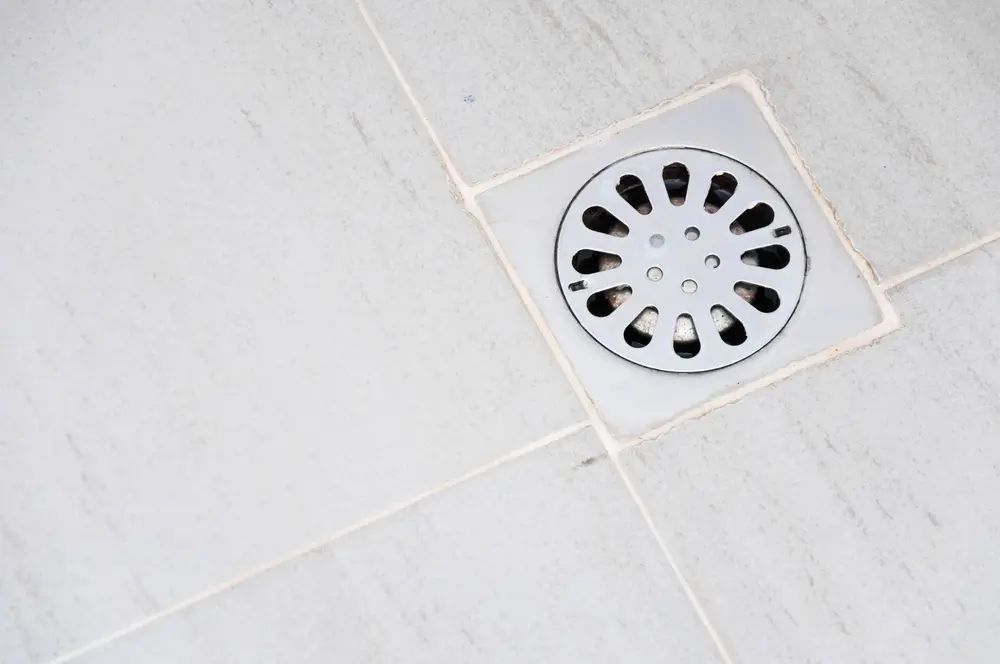A backed up floor drain is a common plumbing issue that can cause water damage if left unchecked. There are several potential causes for a clogged floor drain, but the good news is that in most cases, this problem can be resolved without calling a plumber.
Page Contents
What Causes a Floor Drain to Back Up?
Here are some of the most common culprits for a backed up floor drain:
- Accumulated debris and gunk – Things like hair, soap scum, and food particles can gradually build up in the drain pipe and cause a clog.
- Tree roots – If the drain pipe has any cracks or damage, tree roots from outside can intrude and grow, obstructing water flow.
- Improper drain slope – Drain pipes need the right slope to allow water to flow out. An improper slope can lead to standing water that doesn’t drain.
- Rust and corrosion – Over time, drain pipes, especially cast iron ones, are subject to rust and corrosion which collects along the bottom and clogs the pipe.
- Collapsed or offset pipe – If the drain pipe has collapsed or shifted out of position, it can create a spot where debris catches and clogs up.
- Grease and fat – Allowing fats, oils, and grease to go down the drain can lead to thick, sticky buildup along pipe walls.
How to Clear a Clogged Floor Drain
If your floor drain has started backing up, try these DIY methods first before calling a plumber:
Use a Plunger
A simple plunger can provide enough suction to dislodge and break up minor clogs. Follow these steps:
- Fill the drain with a few inches of water to provide a water seal.
- Place the plunger directly over the drain opening and press down firmly to form a tight seal.
- Quickly plunge up and down, using fast, forceful strokes. Repeat until the clog is cleared.
Try a Drain Snake
For deeper clogs, use a drain snake, also called an auger. Follow these instructions:
- Start by using the plunger first to try and loosen the clog.
- Insert the drain snake into the drain opening and twist the handle to push the cable down towards the clog.
- Once you feel resistance, keep turning the handle while applying light pressure to work through the clog.
- Retrieve the snake once the cable reaches the bend in the pipe. Reinsert until the clog is cleared.
Use a Wet/Dry Shop Vacuum
A wet/dry shop vacuum can generate strong suction to dislodge a clog. Here’s how to do it:
- First try the plunger, then use the drain snake if needed to loosen up the clog.
- Seal the vacuum nozzle over the drain opening.
- Turn on the vacuum and allow it to run for 30-60 seconds to suck out debris.
- Repeat several times until water starts flowing freely again.
Flush with Boiling Water
For tough organic clogs, boiling water can help dissolve and flush away the material. Be cautious, as this can damage PVC pipes. Follow these precautions:
- Plug any overflows to prevent hot water escaping.
- Boil several pots of water and carefully pour down the drain one after another.
- Let it sit for several minutes to allow the hot water to break things up.
- Flush with cold water for a minute or two to rinse debris after.
Use a Chemical Drain Cleaner
Look for commercial drain cleaning products that are safe for PVC pipes. Follow the product instructions carefully:
- Always start by trying a plunger, snake, or vacuum first.
- Wear gloves and eye protection when handling drain cleaner.
- Remove any drain stoppers and follow product label directions.
- Allow product to sit in drain for specified time before flushing with water.
Avoid using harsh drain cleaners too frequently, as this can damage pipes. Only use occasionally for difficult clogs.
Preventing Future Floor Drain Backups
Once you’ve cleared the clog, take steps to prevent the issue from recurring. Here are some tips:
Install a Drain Screen
A drain screen or cover will catch hair, debris, and other particles before they wash down the pipe. Clean the screen periodically.
Routine Drain Maintenance
Make it a habit to pour a pot of hot water mixed with baking soda and vinegar down the drain monthly to keep things flowing freely.
Avoid Putting Grease Down the Drain
Grease and oil will solidify and coat drain walls. Always dispose in the trash instead.
Check and Repair Pipe Damage
Inspect exposed drain pipes periodically for cracks or offsets that can catch debris. Schedule professional repairs as needed.
Clear Nearby Tree Roots
Tree root intrusion is a common drain clog cause. Keep trees and landscaping trimmed back from exterior drain areas.
Have Drains Professionally Cleaned
For recurrent clogs or difficult situations, call a drain cleaning service to clear the pipes and address any underlying issues.
When to Call a Professional Plumber
Contact a professional plumber if:
- DIY methods fail to clear the clog completely.
- Water continues backing up after trying to clear multiple times.
- Drain backups are frequent or happening closer together.
- You suspect a collapsed or damaged drain line.
- The clog may be located deep in the main sewer drain.
- You notice sewage odors coming from the drain.
A professional plumber has specialized tools like high-pressure jetters that can thoroughly clean out drain pipes and remove stubborn clogs. They can also inspect pipes and determine if repairs or replacement are needed.
Conclusion
Dealing with a backed up floor drain is never fun, but in many cases you can clear out the clog yourself without calling a plumber. Try using a plunger, drain snake, shop vacuum or boiling water. For recurrent clogs or more serious backups, contact a professional plumber to properly diagnose and fix the issue.
